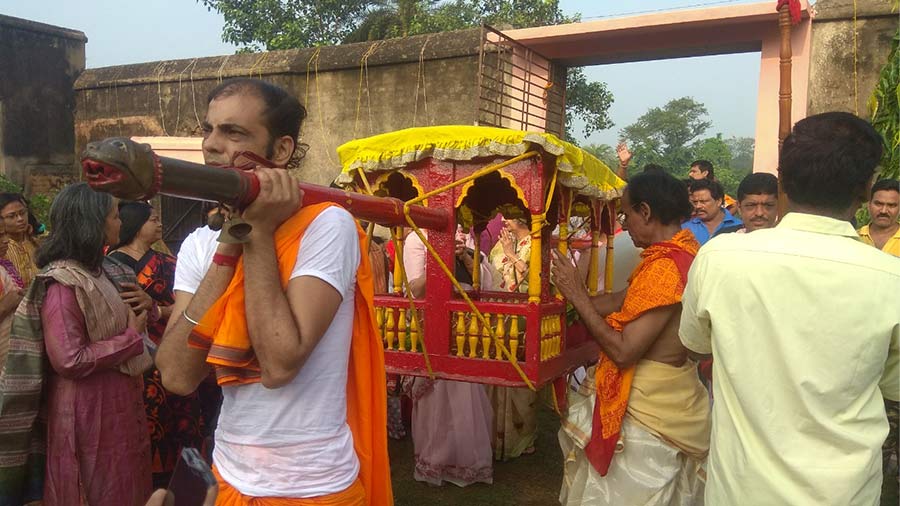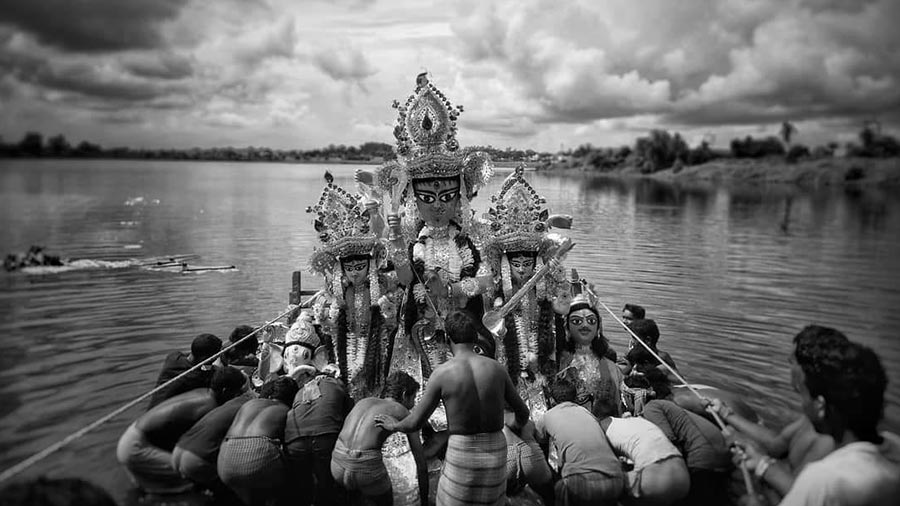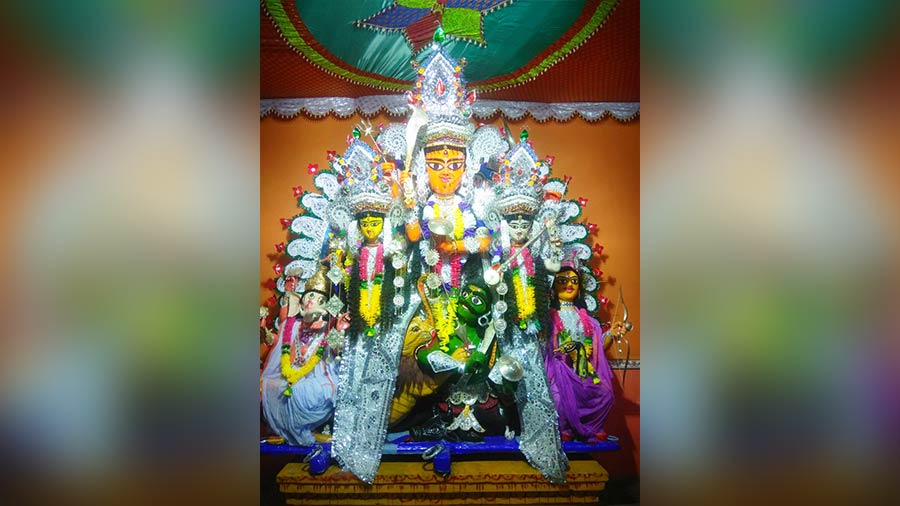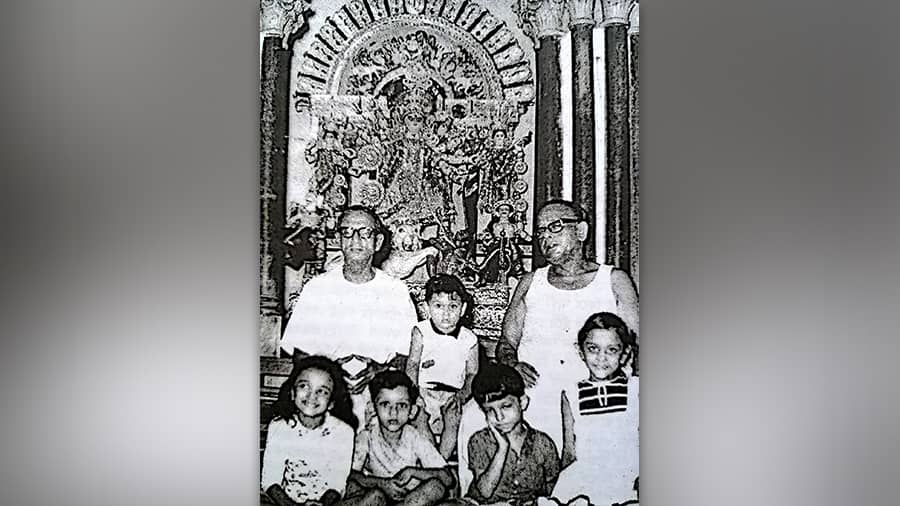When most people think of family Durga Pujas with a legacy, it is old Bengali families or bonedi baris that come to mind. One doesn't quite expect that a family with roots in Punjab can boast of organising a 182-year-old Durgotsav. And yet, the Handas of Ukhra village in Burdwan can claim to have accomplished just that. If one were looking for the perfect example of assimilation, the Handa family Durga Puja would be it.
From Punjab to Bengal
Many will be familiar with the fact that the royal family of Burdwan had roots in Punjab. But what’s lesser-known is that Bengal’s connection to Punjab doesn’t end there. For centuries, there continued a massive migration of people from Punjab to Bengal. These people gradually blended into Bengali society, adopted elements of Bengali culture and eventually developed a Bengali way of life.
The village of Ukhra, 200km from Kolkata, is one region where this confluence can be witnessed. Here, the surnames aren’t Bengali — they are Khanna, Kapoor, Dhawan, Sud, Meheta, Mehetab or Palwar. And yet, all of these families couldn’t have merged better into their chosen home.
The Lal Singh Handa family is a prominent name in Ukhra. The first generation of Handas to settle in Bengal had migrated from Lahore in 1632. Ramchandra Handa, the son of Kewalram Handa, got married to the daughter of Ghanyashyam Kapoor, a member of the royal court of the Burdwan, bringing the family closer to the royal family of Burdwan.
Soon, Meruchand Handa became the dewan to Aliwardhi Khan, the Nawab of Bengal. This led to the family amassing enormous wealth, following which they moved to a place called Shergargh, now known as Ukhra. The family has stayed in this village for over 300 years and has bifurcated into seven branches. It is also worth mentioning that the daughter of Meruchand, Vishnu Kumar, was married to Tilak Chand of the Burdwan royal family, and went on to build 108 Shiva temples in Nababhat of Burdwan, an unmatched contribution to Bengal’s temple architecture.
A bereaved father’s Durga worship

The ‘nabapatrika’ gets carried on the palanquin
The Handa family Durga Puja began in 1841. Sambhunath Handa started the puja after losing his beloved daughter at a very young age and his Durga worship was an attempt to recall his daughter to his home every year. This sentiment has led to the Handa family tradition of worshipping Goddess Durga as a daughter, not a mother.
The idol-making starts on the day following Ratha Yatra, after the bamboo structure of the idol has been worshipped. Today, the idol-maker for the Handa family is Partha Dey, and as is the case with most old family pujas, his father and grandfather had also been idol-makers for the family.
The Handas have a unique ekchala idol. The face of Goddess Durga is made much bigger than other idols and its shape is neither traditional nor modern, making it quite distinctive in appearance.
Puja starts from Mahalaya, with an offering of 108 bel leaves to the goddess. On Panchami, as soon as the daker shaaj is complete, the young boys of the family place the idol on the Durga mandap. Here, the goddess is adorned with century-old golden ornaments and various weapons, all made of silver or gold.
Bodhon is done on Sashthi, and on Saptami morning, the nabapatrika is taken home on a palanquin, just like a bride.
In the bygone days, during Sandhi puja, cannons would be fired to alert all the nearby villages to start their Sandhi pujas. This practice is no longer followed since there is a dearth of good quality gunpowder and to also avoid sound pollution.
After the Dashami puja, all members of the family tie a small piece of aparajita tree trunk on their wrists in memory of the Puja.

A glimpse of the Handa family idol enveloped in smoke from ‘dhuno’
Conventional puja with a touch of uniqueness
The rituals followed by the Handa family puja are quite conventional, although there are a few unique family traditions that set the puja apart. The Handas do not offer sacrifices to the goddess — neither an animal nor a vegetable is offered as boli. The Devi isn’t offered any cooked food as prasad, but a variety of sweets that include chanar jilipi and laddus are offered to her. In the past, the sweets were all made at home but at present, they are ordered from outside. Also, on the day of immersion, after the ritual of devi boron is complete, the seniormost male member of the family offers arati to the devi and puts a tilak on the forehead of the idol. This act is meant to re-enact a father bidding farewell to his married daughter who is ready to go back to her in-laws.
Another unique ritual followed by the Handas is that after the family comes back from the immersion, the young members are given a welcome note and a tilak is put on their foreheads by the elders. Only then can they touch the feet of the elders and do kolakuli and have sweets.

Seconds before the Handa family idol gets immersed
On the evening of the immersion day, a few family members walk down to the old Handa mansion with an earthen lamp and place it at the doorstep of the toshakhana — the vault — where all the ornaments and weapons the idol is decked with were once kept. In the present times, the safety of the ornaments is entrusted to banks.
The new generation of Handas take pride in their puja
Sandip Lal Singh Handa, now 58, proudly claims that he has never missed the family puja in his life. Sandip is optimistic about the future too, as he has seen the immense pride and excitement that the new generation of Handas has for the puja.

Family members pose in front of the idol
“Each passing year,” Sandip says proudly, “the young generation shows more enthusiasm for the puja. Along with them, we the seniors of the family also get engrossed in the five-day-long fiesta, which is all about fun, food, frolic and above all, the heartfelt desire to keep our heritage alive.” In keeping with the times, the Handa family has also started a website for their family puja, hoping to make it a global sensation. The sheer dedication and love that this family has for Durga Puja shows that although their roots are in Punjab, Bengal has long won over their hearts and souls.


